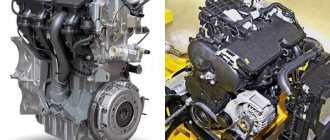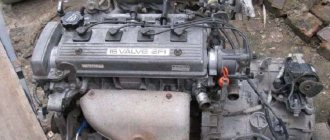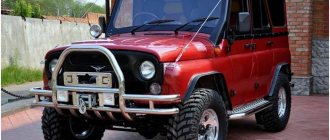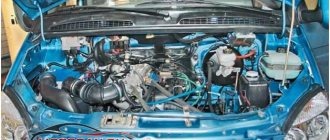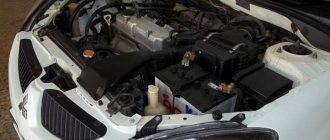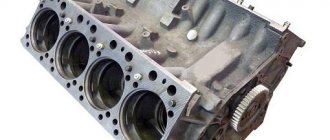About the history of the creation of YaMZ-236 and its predecessors
YaMZ-236 has a solid and glorious history. It began at the turn of the 50s and 60s of the twentieth century, when the design bureau of the Yaroslavl Motor Plant was given the task: to develop and launch into series a modern and economical diesel engine with a “wide profile”, which could be used not only in cars and tractors, but also in many other areas of the national economy.
In the Soviet Union at that time, a course was taken towards the general “dieselization” of heavy vehicles. Most trucks then ran on gasoline and were very uneconomical in terms of fuel consumption. New, modern, highly efficient and economical “engines” running on diesel fuel were supposed to be equipped with heavy-duty vehicles and truck tractors; buses and tractors, various special equipment.
It should be noted that at that time the USSR was actually “ahead of the rest” in terms of the level of development of industrial technologies and engineering. For us, modern people, accustomed to our country lagging behind developed countries in technological terms, this is unusual. But at that time, the new engines, launched into production at the Yaroslavl plant in 1961, the YaMZ-236 and YaMZ-238 (eight-cylinder version) were truly the best in the world.
YaAZ-204 and YaAZ-206 are the “ancestors” of YaMZ-236 and YaMZ-238
These diesel engines became direct “descendants” of the YaAZ-204 and YaAZ-206 diesel engines, which were produced at the Yaroslavl (until 1958 it was called the “automobile”) engine plant. By the time the YaMZ-236 was developed, these two-stroke 4- and 6-cylinder engines were already quite outdated, both technically and morally. After all, they were created on the basis of General Motor’s diesel engines “GMS-4/71” and “GMS-6/71” of the 30s of the twentieth century.
When developing and launching mass production of new generation diesel engines, Soviet specialists relied on the rich experience in diesel production gained in the domestic industry. Remember: the Germans, British and Americans fought the entire Great Patriotic War on gasoline tanks. While in the USSR only pre-war BTs were petrol-powered. Both the legendary T-34 and all subsequent Soviet combat vehicles were diesel.
The group for the creation of new Yaroslavl diesel engines was led by the outstanding Soviet scientist, designer, inventor, Doctor of Technical Sciences Georgy Dmitrievich Chernyshev. With his direct participation, a family of YaMZ engines was created that met the requirements of the time, which became an excellent energy basis for the national economy of the USSR. The state received a powerful, reliable, extremely versatile diesel engine, which has simple maintenance, unpretentiousness and the ability to use cheap spare parts.
In the YaMZ assembly shop. Photo from 2014.
The new YaMZ-236 diesel engine turned out to be so efficient and reliable that it immediately became the only standard one for dozens of different types of equipment, and after more than half a century it continues to be produced at the Yaroslavl Motor Plant - in dozens of different modifications!
Although since then, of course, world technology has gone far ahead, and this motor is no longer the best in the world. In terms of performance and efficiency of use, it can be compared with modern Chinese analogues on the market. But in terms of reliability and maintainability, it is still ahead not only of the “Chinese”, but also of the world’s best analogues “originally” from the most developed countries.
Technical characteristics of the YaMZ-236 Engine
Engine design and layout
The six cylinders of the YaMZ-236 engine are arranged in two rows, at an angle of ninety degrees. The V-shaped arrangement of cylinders was used to reduce the length of the engine and its weight, for a more rational layout and to reduce the weight of the entire car as a whole.
A distinctive feature of these engines is also the rational placement of all units. This goes well with the simplicity of the design, improving their accessibility for both operation and repair. Components and parts that must be regularly maintained during operation are located in easily accessible places, mainly in the front part of the engine, as well as in the camber of the cylinders.
At the top of the front are the fuel filter, air brake compressor and electric generator. They are attached to the top cover of the block. The compressor and generator are driven by a belt from a pulley on the fan shaft. Also located in front are the water pump and power steering. They are started by a pulley directly from the engine crankshaft. On the left, at the front end of the cylinder block, there are oil filters - coarse and centrifugal oil purification. The oil pump, which is located on the front main bearing cover, also operates from the crankshaft gear.
YaMZ-236, just released from its wooden factory packaging.
The electric starter for starting the engine is located on the lower right side. The crankcase is protected from below by a sump, which is also a container for the engine’s lubrication system. On the mating surfaces of each cylinder bank there are interchangeable cylinder heads. The gas distribution system valves and injectors are also located there. The valve mechanisms are closed with steel covers, one of which has a pipe for filling engine oil.
On the side, on the outer sides, exhaust pipelines are attached to the side surfaces of the heads; on the camber sides - inlet and drainage pipes, with cooling system thermostats. The air filter is located in a special adapter into which all intake pipes are combined. The high pressure fuel pump is located in the cylinder camber. It is installed assembled with a speed regulator, an automatic diesel fuel injection advance clutch and a fuel booster pump.
Now the layout is at the back. The flywheel housing is attached to the rear end of the cylinder block. This crankcase is equipped with a hatch at the bottom, closed with a steel cover-stamp. The clutch is mounted on the flywheel, and behind the end of the flywheel housing there is a gearbox with a clutch housing.
Main characteristics in numbers
YaMZ-236 diesel engines are available as naturally aspirated (basic version) and turbocharged. The power range starts at 150 horsepower, or 110 kW (for the derated version of the YaMZ-236G) and varies up to 300 horsepower, or 220 kW, for the forced version with turbocharging.
Overall dimensions of the YaMZ-236 engine:
- Length without gearbox and clutch: 1020 mm;
- Length with gearbox and clutch: 1800 mm;
- Width: 1006 mm;
- Height: 1195 mm.
Weight of the YaMZ-236 engine (dry, unfuelled):
- Without auxiliary equipment: from 820 to 1010 kg;
- With a set of auxiliary equipment: from 880 to 1070 kg;
- With a set of auxiliary equipment, plus clutch and gearbox: from 1170 to 1385 kg.
- The working volume of the combustion chamber is 11.15 liters (11,150 cubic centimeters).
- The maximum torque ranges from 667 to 1275 Nm, at 1200-1500 rpm.
- Cylinder diameter: 130 mm; piston stroke: 140 mm; compression ratio - 17.5.
- Min. specific fuel consumption: 214 (157) g/kWh (g/hp.h)
Engine YaMZ-236M2: features, applications, characteristics
The YaMZ-236M2 atmospheric diesel engine has a displacement of 11.15 liters and a power of 180 hp . Euro-0 environmental standards . (Yaroslavl Motor Plant). Produced since 1988 in various configurations , including a mechanism for damping torsional vibrations and power take-off, and a liquid-oil heat exchanger. It should be noted that it can be purchased both complete with gearboxes and without them, and diesel engines can also be repaired in our diesel centers.
Device
The YaMZ-236M2 engine is equipped with 6 cylinders with a V-shaped arrangement at an angle of 90 degrees, dimension D?S=130?140 mm. The diesel engine is four-stroke, compression-ignited, has direct fuel injection and liquid cooling.
The power supply system includes an in-line mechanical injection pump with one pump section per cylinder. Fuel injection pump drive with a centrifugal clutch with automatic regulation of fuel injection advance. Located in the camber of the cylinder block.
The diesel engine uses an OHV valve mechanism, which provides 2 valves per cylinder. The rods are equipped with roller pushers. The location of the crankshaft crank pins at an angle of 120° provides flashes every 90 and 150 degrees.
The cylinder liners are cast from high-strength cast iron, and the camshaft and crankshaft are made from stamped steel. The pistons are cast from aluminum alloy (high silicon).
| Model | YaMZ-236 M2 | YaMZ-236 M2-1 | |
| Minimum specific fuel consumption, g/kW h (g/hp h) | 214 (157) | ||
| Clutch | YaMZ-236K | — | YaMZ-236K |
| checkpoint | YaMZ-236P | — | YaMZ-236P |
| Dimensions, mm | 1840?1040?1070 | 1020?1040?1220 | 1840?1040?1070 |
| Weight, kg | 1205 | 890 | 1205 |
| Generator, model | 1322.3771 or G273 V2 | ||
| Applicability | Self-propelled cranes KS-4372v, KS-5871 (PO Yurmash LLC, Yurga) - for spare parts | Marine engines (JSC Bogorodsky Machine Plant), marine diesel gear units (JSC Tyumen-Sudokomplekt) - for spare parts | Cars, chassis MAZ-53371, MAZ-53371-020, MAZ-53371-031, MAZ-5337; dump truck MAZ-5551; truck tractors MAZ-54331, MAZ-543208; timber trucks MAZ-54341 - for spare parts |
| Model | YaMZ-236 M2-2 | YaMZ-236M 2-4 | |
| Minimum specific fuel consumption, g/kW h (g/hp h) | 1214 (157) | ||
| Clutch | YaMZ-236K | YaMZ-236K | — |
| checkpoint | — | YaMZ-236U | — |
| Dimensions, mm | 1135?1040?1220 | 1840?980?1110 | 1020?980?1110 |
| Weight, kg | 960 | 1185 | 890 |
| Generator, model | 1702.3771 | 1702.3771 | |
| Applicability | Cars, chassis “Ural-432067”, “Ural-432007-10”; dump truck "Ural-5557-10" and their modifications; AGMS railcars (DSUE "PMZ", Perm); Compressor stations PV-Yu/8M1, NV-Yu/8M2 (JSC Mashzavod, Chita) | Motor grader A120, loader B138, bulldozer TS-10 Dobrynya (JSC ChSDM, Chelyabinsk); Ural cars - for spare parts; AGMS railcars (DSUE "PMZ", Perm) | Compressor stations PV-10/8M1, NV-10/8M2 (JSC Mashzavod, Chita); front loader B138, bulldozer TS-10 “Dobrynya” (JSC “ChSDM”) |
| Model | YaMZ-236M2-7 | YaMZ-236M2-15 | YaMZ-236M2-19 | YaMZ-236M2-26 |
| Minimum specific fuel consumption, g/kW h (g/hp h) | 214 (157) | 227 (167)* | ||
| Clutch | — | — | YaMZ-181 | — |
| checkpoint | — | — | YaMZ-236U5 | — |
| Dimensions, mm | 1020?1040?1220 | 1840?980?1110 | 1020?1040?1110 | |
| Weight, kg | 895 | 1160 | 890 | |
| Generator, model | 1322.3771 or G273 V2 | 1322.3771 | 1702.3771 | 1322.3771 or G273 V2 |
| Applicability | Power plants and electric units AD60, ED60 with a capacity of 60 kW (JSC Elektroagregat, Kursk); diesel generator sets (ZAO Tyumen-Sudokomplekt); excavator ET-26 (EZ Kovrovets LLC) | For spare parts for excavators EK-270, EK-2701.S (JSC MK KRANEKS, Ivanovo) manufactured before 01/01/02 | Cars "Ural-43206", "Ural-4320-10" with a clearance of 1.2 m - for spare parts | Excavator EZO (FSUE PA Uralvagonzavod, N. Tagil) |
| Model | YaMZ-236M2-28 | YaMZ-236M2-31 | YaMZ-236M2-32 | YaMZ-236M2-33 |
| Minimum specific fuel consumption, g/kW h (g/hp h) | 227 (167)* | 214 (157) | 227 (167)* | 214 (157) |
| Clutch | YaMZ-236K | YaMZ-181 | — | YaMZ-236K |
| checkpoint | — | YaMZ-236UZ | — | YaMZ-236U4 |
| Dimensions, mm | 1130?1040?1070 | 1840?980?1110 | 1020?1040?1220 | 1840?980?1110 |
| Weight, kg | 985 | 1160 | 890 | 1185 |
| Generator, model | 1322.3771 or G273 V2 | 1702.3771 | 1322.3771 or G273 V2 | 1702.3771 |
| Applicability | Excavator EO-5119 (JSC "EXCO", Kostroma); road rollers DU-84, DU-85, DU-85-1, DU-101 (ZAO Raskat, Rybinsk) | Cars, chassis “Ural-43206”, “Ural-4320-10”; dump truck "Ural-5557-10" and their modifications | Excavator EK-270-05 (JSC MK KRANEKS, Ivanovo) | Vehicle "Ural-4320-10" with a clearance of 1.2 m |
| Model | YaMZ-236M2-39 | YaMZ-236M2-41 | YaMZ-236M2-48 | YaMZ-236M2-52 |
| Minimum specific fuel consumption, g/kW h (g/hp h) | 214 (157) | |||
| Clutch | YaMZ-236U5 | YaMZ-236KM | — | YaMZ-181-15 |
| checkpoint | YaMZ-236K | YaMZ-236U1 | — | YaMZ-2361-58 |
| Dimensions, mm | 1845?980?1110 | 1840?980?1110 | 1020?1040?1220 | 1845?980?1110 |
| Weight, kg | 1185 | 895 | 1185 | |
| Generator, model | 1702.3771 | 1322.3771 or G273 V2 | 1702.3771 | |
| Applicability | Vehicle "Ural-43206" with a clearance of 1.7 m | Cars, chassis "Ural-432067", "Ural-432007-10", dump trucks "Ural-5557-10" and their modifications | Diesel power plants AD-60 with a capacity of 60 kW produced by JSC Avtodizel (YaMZ) | Cars "Ural-43206" (ford 1.7 m) |
Application
The YaMZ-236M2 diesel engine is widely used due to its unpretentiousness, good power qualities and the ability to operate in various climatic conditions. A wide range of configurations allows it to be installed on equipment for various purposes:
- MAZ and Ural cars,
- city buses MARZ and AMAZ,
- bulldozers and excavators,
- motor graders, road rollers and loaders,
- self-propelled cranes,
- ship engines and units,
- railway track machines,
- agricultural machinery,
- diesel generators, compressor and power plants.
The reliability of this engine allows it to be used in army and firefighting vehicles, fuel trucks and timber trucks. YaMZ-236M2 is in demand as a replacement for outdated standard engines from other manufacturers. YaMZ-236M2 engines in any configuration show excellent performance even when operating in the most unfavorable climate.
Interesting fact: In 2012, the Ural-43206 vehicle, equipped with a YaMZ-236M2 engine, was chosen by polar explorers for use at the Artigas scientific base. Over the past time, it has performed excellently in the harsh conditions of the South Pole, where there are extremely low temperatures, heavy snowfalls and winds. At the same time, the total weight of the vehicle is 12.1 tons, the weight of the transported cargo is more than 4 tons, and the total weight of the towed trailer can reach 7 tons. The power of the YaMZ-236M2 is enough for such a vehicle to easily overcome a ford with a depth of up to 1.75 meters and an ascent of up to 58 degrees, with a maximum speed of up to 90 km/h.
The most important advantage of these diesel engines is ease of maintenance and high maintainability, as well as the possibility of extremely fast commissioning.
Main elements of the YaMZ-236 engine
Cylinder block/crankcase
The main body part of the engine is its crankcase, which is a special spatial casting made of low-alloy gray pearlitic cast iron. This casting is processed using the “artificial aging” method in order to eliminate thermal stress and maintain precise geometric shapes during operation.
The cylinder liners, machined into the block, are thick-walled and centered along two concentric bores in the block plates at the top and bottom. The row of cylinders on the right is shifted relative to the opposite one by thirty-five millimeters to accommodate two connecting rods on a common crankpin.
YaMZ-236 cylinder block
Each of the cylinder nests is equipped with two coaxial cylindrical holes made in the upper and lower plates of the block. The top plate also has ring grooves for sleeve collars. On the inner walls of the cylinder block there is a system of oil channels that serves to continuously drain lubricant to the camshaft and crankshaft bearings, the oil filter and the liquid-oil heat exchanger.
Cylinder head of the YaMZ-236 engine
The cylinder head of the basic Yaroslavl diesel engine is a solid cast iron, attached to the cylinder block with heat-treated chrome-nickel steel studs. To ensure the removal of excess heat, the cylinder head is equipped with a separate water jacket, shared with the water jacket of the entire block.
Inside the cylinder head there are pressed valves equipped with springs and fastening parts; as well as rocker arms with axles and injectors. The valve seats are plug-in, made of special cast iron and heat-resistant alloy. The saddles are pressed into the sockets with tension. The joints of the cylinder head, block and liners are sealed with one sandwich gasket, common for three cylinders.
Crankshaft of the YaMZ-236 engine
The crankshaft of the YaMZ-236 engine is made of 50G steel using the hot stamping method. The crankshaft journals are hardened by heating with high-frequency currents. There are four main supports of the crankshaft, three connecting rod journals. The connecting rod journals have additional internal cavities in which the oil is subjected to centrifugal cleaning. Counterweights are installed on the cheeks of the crankshaft, together with which it is installed and adjusted (balanced).
Axial fixation of the crankshaft in the engine is ensured by four bronze half-rings mounted in the recesses of the rear main support. The toe and shank of the crankshaft are sealed with special self-tightening seals made of reinforced rubber.
Flywheel on YaMZ-236
The flywheel of the basic Yaroslavl engine is cast from gray cast iron. It is attached to the rear end of the crankshaft with bolts made of special alloy steel. These bolts are protected from spontaneous rotation by locking plates. The flywheel is equipped with a steel ring gear to start the engine with a starter. The crown is secured to the front end of the flywheel with twelve bolts, secured with special flap washers.
Flywheel of YaMZ-236 engine
12 radially located holes on the flywheel are designed to rotate the crankshaft when making engine adjustments. The shape and location of the cavities at the front end of the flywheel provide the directional imbalance necessary for the balancing system. The flywheel balancing process is carried out separately from the crankshaft, so all flywheels are interchangeable.
YaMZ-236 engine connecting rod
The connecting rod is made of forged steel “40X”, has an I-section; the connector of its lower head is oblique, at an angle of 55 degrees. Replaceable liners are installed in the lower head of the connecting rod, and a steel/bronze OCS bushing with an outer diameter of 56 mm is pressed into the upper head. In the upper connecting rod heads of the YaMZ-236 engines of the previous production heads, two steel/bronze bushings were pressed into place, and the annular space between them was used to supply oil to the piston pin.
Pistons, piston pins and rings for YaMZ-236
The pistons installed on YaMZ-236 engines are made of high-silicon eutectic aluminum alloy. To improve the running-in of the piston to the liner, its surface is covered with the thinnest (0.003-0.006 mm) layer of tin. The piston skirt has a special recess for the cooling nozzle; as well as two side recesses so that the crankshaft counterweights do not touch the piston during operation.
The outer surface of the piston is equipped with five grooves for piston rings. The three upper grooves are reserved for the installation of compression rings. One groove is above the piston pin and another one is in the lower part of the piston skirt - to accommodate the removable rings.
YaMZ-236 engine in section
The piston pin, which serves to connect the piston to the connecting rod, is hollow, floating type. It is made from steel 12-ХН/ЗА. The outer surfaces of the fingers are cemented to a depth of 1.0-1.4 mm; are subjected to hardening and tempering to a hardness of NKS 56-65. The outer diameter of the pin is 50 mm.
The piston rings on the YaMZ-236 are cast from special cast iron and installed in the piston grooves in a certain order (see above). They are chrome plated and split. Compression and low-removal rings differ from each other by different types of cross-section.
Gas distribution mechanism of the YaMZ-236 engine
The gas distribution mechanism on the YaMZ-236 is overhead valve, with a lower camshaft. The valves are driven by pushers, rods and rocker arms. The main elements of the mechanism are as follows: camshaft, with drive gear and bearings; pushers and pusher axles; rods and rocker arms with adjusting screws and axles; valves with springs and guide bushings.
The camshaft is forged and made from 45 carbon steel; The tappets are also steel, stamped, oscillating type with a roller for contact with the camshaft cams. Inlet and exhaust valves are made of special heat-resistant steel.
YaMZ-236 engine lubrication system
The lubrication system on YaMZ-236 engines is used of a mixed (combined) type, with a “wet” sump. The oil supply is provided by a fully unified gear-type oil pump. The oil pump consists of two sections (pressure and radiator). The pressure section pumps oil into the engine lubrication system, and the radiator section pumps it through the radiator.
YaMZ-236 power supply system
Split type power supply system. It consists of a high-pressure fuel injection pump, with a fuel priming pump and regulator, an injection advance clutch, injectors, fuel filters, and fuel lines. In accordance with the operating order of the cylinders, the injection pump pumps diesel fuel through high-pressure pipelines to the injectors, which inject the next “portion” of atomized fuel into the cavities of the cylinders. Through the bypass valve and the fine filter nozzle, excess fuel is discharged back into the fuel tank.
Modifications of the YaMZ-236 engine and their scope of application
There are 35 modifications of the “aspirated” YaMZ-236: without turbocharging, with power from 150 to 195 hp. Detailed specifications for each of them are available on the Yaroslavl Motor Plant website. The scope of application of these engines is as follows: marine engines; compressor stations; electrical units; marine diesel electrical installations; railway handcars; excavators, road graders and rollers, self-propelled cranes, front loaders, bulldozers, all-terrain vehicles, armored personnel carriers, ZIL, Ural, MAZ vehicles (mostly Soviet ones from previous years of production).
MAZ-5551 car with YaMZ-236M2-1 engine
There are 54 turbocharged modifications of the YaMZ-236, their power varies from 230 to 300 horsepower. They are equipped with modern buses; combines; tractors and special equipment from various manufacturers; some variants of MAZ and Ural cars.
Reviews about YaMZ engines
The Yaroslavl Motor Plant has been producing the famous YaMZ engines for almost a century. If you believe the reviews of owners of vehicles with these engines, the units have gained popularity due to their versatility, reliability and trouble-free operation.
YaMZ-236 and 238 engines are the most commonly used options for a variety of special equipment and vehicles. The main scope of motors is very wide, as they have many modifications. Motors are installed on:
- shipping machinery;
- compressor stations;
- electrical units;
- excavators;
- railway handcars;
- road special equipment - rollers, graders;
- self-propelled cranes;
- bulldozers, all-terrain vehicles, armored personnel carriers;
- cars ZIL, KAMAZ, URAL, MAZ.
YaMZ-236 on the modern market: the cost of these engines and reviews about them
The price for a new naturally aspirated engine YaMZ-236 ranges from 370 to 450 thousand rubles; for YaMZ-236 with turbocharging - from 480 to 650 thousand rubles. From time to time the opportunity arises to purchase YaMZ-236 a little cheaper: from the storage of the State Reserve, new, in pallets. At half the price of a new one, you can find used YaMZ-236 or individually assembled motors (after overhaul) on ad sites.
For the modern development of technology, YaMZ-236 diesel engines have rather mediocre specific performance and efficiency indicators. The design, outdated over the past half century, does not allow these engines to comply with Euro-3 standards and higher. The turbocharged versions were modified to Euro-2 standards.
Modern Rostov Vector combines are equipped with a YaMZ-236ND motor
However, their unsurpassed reliability and unpretentiousness; the low price (compared to imported analogues) for the motors themselves and spare parts for them helps maintain stable demand for these products. Reviews about the YaMZ-236 boil down to one thing: fuel consumption, by today's standards, is high, but the reliability is simply excellent. Even in large ATPs, where bus drivers periodically change and there is no need to talk about careful handling of equipment, YaMZ-236 engines honestly work out the resource declared by the manufacturer of 800 thousand kilometers. And they continue to work, without serious breakdowns, without requiring major repairs for a long time.
Technical characteristics and device
The technical characteristics of the YaMZ 236 engine have not changed much since the start of engine production. Only some technical and design elements have been added, such as turbocharging, power supply or exhaust gas systems.
Technical characteristics of the YaMZ 236 motor.
The main technical characteristics of the internal combustion engine 236 YaMZ.
| Name | Characteristic |
| Type | Diesel, turbocharged diesel |
| Volume | 11 liters (11,150 cm3) |
| Configuration, parameter | V-shaped |
| Number of cylinders | 6 |
| Number of valves | 12 |
| Econorm | from Euro-0 to Euro-4 |
| Cylinder diameter | 130 mm |
| Compression ratio | 17,5 |
| Cooling | Liquid |
| Valve mechanism | OHV |
| Material of block and head | Cast iron |
| Resource | 800,000 - 1,000,000 km |
| Fuel | Diesel fuel |
| Cylinder operating order | 1-4-2-5-3-6 |
| Applicability | MAZ, KRAZ, URAL, T series tanks, K tractors, LAZ buses, CHETRA all-terrain vehicle and more |
Motor modifications
At different times, there were different modifications of engines manufactured by the Yaroslavl Motor Plant. So, what types can be found on cars:
Engine YaMZ 236.
- YaMZ-236G - 150 hp. (110 kW) at 1700 rpm.
- YaMZ-236DK - 175 hp. (129 kW) at 2100 rpm, 667 N•m (68 kgf•m) at 1400 rpm.
- YaMZ-236ND - 210 hp. (154 kW) at 1900 rpm, 882 N•m (90 kgf•m) at 1300 rpm.
- YaMZ-236N - 230 hp. (169 kW) at 2100 rpm, 882 N•m (90 kgf•m) at 1300 rpm.
- YaMZ-236BK - 250 hp. (184 kW) at 2000 rpm, 1030 N•m (105 kgf•m) at 1200 rpm.
- YaMZ-236B - 250 hp. (184 kW) at 2000 rpm, 1030 N•m (105 kgf•m) at 1300 rpm.
- YaMZ-236BE2 - 250 hp. (184 kW) at 2000 rpm, 1078 N•m (110 kgf•m) at 1200 rpm.
- YaMZ-7601 - 300 hp. (220 kW) at 1900 rpm, 1275 N•m (130 kgf•m) at 1200 rpm.
Applicability
YaMZ 236 engines have become quite widely used. Thus, about two dozen brands and more than 40 models of cars, buses, military vehicles and construction equipment are still equipped with legendary engines.
URAL with YaMZ 236 engine.
The URAL-4320 with the YaMZ 236 engine has become quite popular. In addition to this brand of engine, there is also an older brother - the YaMZ-238. This motor is much more powerful, and therefore is installed on heavy construction equipment, tractors, and even strategic military vehicles.
Why have YaMZ engines become widespread? Unlike their Western counterparts, domestically produced power units are quite easy to repair and do not have a large amount of electronics, which makes repairs possible in the field.
Also, the motors have the necessary power so that the vehicle can pull a load even in the most difficult conditions. For example, sand that gets into the fuel system is not a hindrance, and it is easily removed from the engine.
So, let's look at which vehicles the YaMZ-236 power unit can be found on:
- The first in line, of course, are MAZ cars. The engines can be found on such models as: 500, 503, 504, 509, 516, 5335, 5549, 5551 and others.
- The second most widely used vehicle is the KRAZ: 255, 250, 257, 260 and 6322.
- Also installed on URAL series vehicles: 4320, URAL 5323.
- Also, the YaMZ-236 engine was also used on KAMAZ. So, the model 5320 was equipped from 1976 and 2000.

